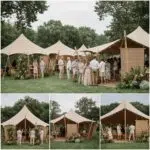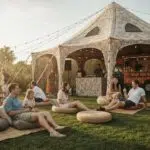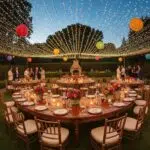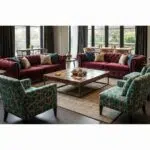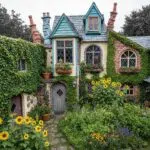The success of any wedding party often hinges on the details that create an unforgettable ambiance. Unique wedding party accessories—such as bespoke bars, one-of-a-kind photo booths, and comfortable lounge areas—bring a touch of individuality and charm tailor-made to each celebration. Couples increasingly seek rentals that not only serve functional purposes but also deliver a visual narrative that mirrors their personality and theme. These accessories, ranging from custom-designed bars that serve signature cocktails to interactive photo booths that capture spontaneous moments and lounge areas curated for guest comfort, set the stage for an immersive experience. In today’s competitive event rental market, incorporating premium elements like sophisticated floral tableware, specialized lighting setups, and accessory integrations that complement a wedding’s overall design are critical to elevating the celebration.
Event planners and coordinators are constantly on the lookout for items that blend aesthetics with practicality. With considerations like accessibility, innovative design, and the incorporation of modern technologies such as javascript-driven interactive displays or advanced lighting systems, the wedding industry is evolving. Whether planning an intimate ceremony in San Antonio or a grand affair in Dallas, the right blend of style and functionality can transform any event space into a dream setting. This article explores the key concepts behind unique wedding bar concepts and features, innovative photo booth installations, and thoughtful lounge area arrangements that elevate the guest experience—all designed to generate leads and drive bookings for premium event rentals.
Unique Wedding Bar Concepts and Features

Wedding bars today are much more than just a place to serve drinks; they are a statement piece that reflects the couple’s style and the overarching wedding theme. Modern wedding bars integrate custom design and layout options that ensure every inch of the space is optimized for both functionality and aesthetics. Custom designs can include tailored backsplashes, intricate countertop patterns, and themed decorations that resonate with the wedding’s color scheme—sometimes featuring elements like floral arrangements or velvet accents. This not only enhances the venue’s visual appeal but also creates an inviting and sophisticated focal point for guests to mingle.
Custom Design and Layout Options
The success of a wedding bar starts with its design and layout. Custom design options allow couples to choose everything from the bar’s structure to its finishes—integrating materials like glass, wood, or even linen drapes to soften the look. These personalized touches are crucial in reflecting the couple’s unique vision, whether they desire a modern, sleek bar with a minimalist aesthetic or a sprawling, ornate setup reminiscent of a historic cocktail lounge. For example, a wedding hosted in Colorado might feature rustic wood accents combined with contemporary bar elements to balance tradition with modern trends. Well-designed layouts also ensure easy accessibility for both the bartenders and the guests, enabling seamless interaction and efficient service, even during high traffic.
Signature Cocktail Menu Integration
Integrating a signature cocktail menu amplifies the wedding bar’s uniqueness by offering guests a taste of creativity specially crafted for the occasion. Couples have the option to work with experienced mixologists who design cocktails that reflect personal stories or significant milestones in their relationship. The integration of a custom cocktail menu supports both the visual design and the flavor profile of the event, further emphasizing the attention to detail. Incorporating seasonal ingredients, liquors, and even locally sourced produce can align the beverage offerings with the wedding’s theme, whether it’s a casual outdoor celebration or a formal, indoor affair. This approach not only enhances the guest experience but also bolsters the bar’s role as an interactive storytelling element.
Lighting and Ambiance Enhancements
Lighting plays a pivotal role in setting the mood and highlighting the wedding bar’s aesthetic features. State-of-the-art lighting systems, including LED fixtures and ambient uplighting, can be utilized to create dynamic and dramatic zones that alter the bar’s appearance as the day transitions into evening. Thoughtful lighting and ambiance enhancements ensure that the colors on the signature cocktail menu and decorative details like floral and textured backdrops are brought to life, creating an inviting atmosphere. This technique contributes to a sophisticated ambiance that elevates the overall event, making the bar not just functional but a central piece of decor within the reception space.
Coordinating Bar Placement With Event Flow
Ensuring seamless interaction between the bar area and other segments of the wedding venue is essential for maintaining a fluid event flow. Coordinating bar placement can involve positioning the bar near the main dining or social areas, ensuring that guests easily access beverage services without causing disruptions. The strategic location can also serve as a conversational hub, linking the thematic elements of the wedding with the overall guest experience. For instance, integrating the bar area into the venue’s layout can involve thoughtful spatial planning that connects flow from the entrance to the dance floor, enhancing both service efficiency and guest satisfaction.
Tips for Vendor Collaboration
Collaboration among vendors is critical to successfully executing a cohesive wedding party accessory experience. When event planners, rental companies, and catering professionals work in unison, they can achieve a unified style that satisfies all aspects of the event—from sophisticated tableware displays to the elegant integration of photo booths and lounge areas. Clear communication about design visions, technical requirements (such as lighting and electrical needs), and logistics ensures that the execution is smooth. Regular vendor meetings or coordinated walkthroughs before the event can help preempt potential issues, ensuring every detail fits perfectly within the overall theme and spatial layout. This collaborative approach ultimately leads to enhanced customer service and a memorable guest experience.
One-of-a-Kind Photo Booth Installations

Photo booths continue to revolutionize wedding entertainment, offering guests a fun and interactive way to capture memories while contributing to the overall event theme. One-of-a-kind photo booth installations not only provide high-quality entertainment but also serve as an extension of the wedding’s design narrative. These installations can be fully customized to match the wedding’s ambiance, ensuring that every snap taken resonates with the event’s overall aesthetic.
Creative Backdrop and Theme Selections
Selecting a creative backdrop for a photo booth is paramount to capturing the spirit of the wedding. Couples can opt for backdrops that include floral textures, elegant drapes, or even custom-printed graphics that embody their love story and chosen color palette. For example, a wedding in San Diego might pair a coastal-inspired backdrop with subtle nautical themes, creating a refreshing yet chic visual that complements the overall decor. The theme of the photo booth should not only align with the wedding’s motifs but also engage guests through visually stimulating elements that encourage candid and playful interactions.
High Quality Tech and Interactive Props
State-of-the-art technology is a must-have in modern photo booth installations. High-resolution cameras, touchscreen interfaces, and digital filters enhance the overall experience, allowing guests to enjoy professional-quality prints and instant sharing options. Interactive props, ranging from whimsical hats and oversized glasses to custom signage that reads witty phrases, add an extra layer of entertainment. These elements encourage guests to get creative and participate actively, thus enhancing engagement. The use of technology-backed features also provides a practical solution for events where maintaining visual consistency (using options like floral cake tableware or velvet accents) across various photo prints is crucial for preserving the wedding theme.
Custom Settings for Personalized Branding
Photo booths offer the luxury of personalized branding. Through custom settings, couples can incorporate their names, wedding date, and even a unique hashtag directly onto photo strips. This personal touch plays an essential role in reinforcing the wedding’s overall design. Whether integrated with digital templates using javascript-driven software or achieved through physical print customization, personalized branding makes each photo a cherished keepsake. As guests see their moments framed within the context of the wedding’s bespoke style, it reinforces the narrative and elevates the event’s sophistication. This level of detail drives home the idea that every element of the wedding has been meticulously planned to create a harmonious celebration.
Optimizing Photo Booth Venue Placement
Strategic photo booth placement can significantly impact the guest experience. Planners should consider situating the booth within a high-traffic area that does not obstruct the flow of the event, yet is visible enough to draw interest. Optimal placement near the dance floor or close to the entrance ensures that guests can easily find and interact with the booth, creating natural conversation starters. Evaluating the lighting and ambient conditions of the chosen spot beforehand, including potential interplay with floral or glass decor, helps maintain photo quality and consistency in print outputs. Moreover, coordinating the booth’s placement with overall event logistics ensures that it meshes well with other elements like the wedding bar or lounge area arrangements.
Safety and Setup Best Practices
Ensuring the safety and proper setup of photo booth installations is critical given the high guest interactions. Secure mounting of equipment, adequate wiring management, and clear instructions for use help avoid accidents while enhancing usability. Vendors should ensure that the setup complies with venue guidelines and that there is enough space to accommodate the equipment without hindering traffic. Additionally, backup power solutions and technical support on-site can resolve any hiccups swiftly, ensuring that the booth remains operational throughout the event. Emphasizing safety also extends to the use of props and interactive elements, ensuring they are robust and well-maintained to prevent any incidents during a high-paced event.
Comfortable Lounge Area Arrangements

Creating comfortable lounge areas within a wedding reception is essential to provide guests with spaces to relax, converse, and recharge. Lounge setups are carefully curated to combine design, functionality, and aesthetic appeal, using a blend of curated furniture, flexible seating, and mood lighting to foster a cozy yet sophisticated environment. These areas often serve as quiet retreats where guests can enjoy amenities like curated tableware, special event rentals, and even interactive decor elements that complement the overall wedding theme.
Curated Furniture and Decor Collections
Lounge areas rely heavily on curated furniture collections that reflect the overall theme of the wedding. Designers often select pieces that blend comfort with style, such as plush velvet chairs, elegant glass coffee tables, and artfully designed sofas. Each piece is chosen not just for its visual appeal but also for its ability to provide a durable, accessible seating option that aligns with the high standards of customer service expected at premium events. Lounge areas might feature a mix of modern and vintage pieces that collectively evoke an atmosphere of sophistication and ease. The careful coordination of decor items—ranging from floral arrangements to delicate tableware—ensures that every detail contributes to a cohesive design narrative that impresses guests.
Flexible Seating Configurations
Flexibility in seating arrangements is vital for accommodating various guest interactions and event dynamics. Event planners often design lounge areas with modular seating that can be easily reconfigured to suit impromptu gatherings or quiet conversations. This versatility ensures that regardless of the guest count or time of day, there exists a comfortable arrangement to facilitate both group engagements and intimate discussions. Configurations might include circular seating clusters, linear arrangements near a central coffee table, or even mixed setups that encourage movement and social interaction. By adapting seating arrangements based on guest dynamics, planners create spaces that are both efficient and welcoming, reducing any obstacles that might inhibit social connectivity or comfort.
Mood Lighting and Textural Accents
Enhancing lounge areas with well-planned mood lighting contributes significantly to the ambiance. Soft, adjustable lighting that complements the wedding’s theme sets a relaxed tone and draws attention to key design aspects such as textured wall panels or elegant tableware displays. In addition to lighting, textural accents like luxurious cushions, soft throws, and delicate linen drapes provide a sensory richness that elevates the guest experience. For weddings, where design elements often include a mix of cash and floral inspirations, mood lighting plays the dual role of accentuating decor and ensuring that the space remains visually engaging throughout different phases of the event—from a sunlit afternoon to a starlit evening.
Space Planning for Social Interaction
Effective space planning is crucial to ensuring that the lounge areas promote social interaction while offering moments of respite. Planners must pay close attention to the traffic flow and sightlines to create zones that naturally draw guests in. Balancing open areas with semi-private nooks allows for flexibility, enabling guests to form spontaneous groups or engage in quiet one-on-one conversations. Strategically placed seating near interactive installations—like a nearby photo booth or a stylish bar—encourages smooth transitions between different event areas, ensuring that the lounge remains an integral part of the overall celebration. This thoughtful planning not only enhances guest comfort but also ensures that every space within the venue contributes to the overall theme.
Accessory Integration to Suit Wedding Themes
Accessories play a pivotal role in tying together the ambiance of lounge areas with the wedding’s overarching theme. Items such as decorative throw pillows, artfully arranged floral elements, and designer tableware can enhance a space’s character while maintaining a sense of visual unity. For instance, in a wedding inspired by the elegance of Atlanta events, accessories might include minimalist sculptures combined with lush floral arrangements that emphasize color coordination and supportive lighting. These accessories are chosen not solely for decoration but also for their ability to contribute to guest comfort and spatial coherence. By integrating themed accessories, designers ensure that the lounge area feels like a natural extension of the wedding’s styled décor, enhancing both visual appeal and overall functionality.
Integrating Wedding Rentals Into a Cohesive Theme

Ensuring that every component of a wedding—from the bar and photo booth to the lounge area—aligns with a cohesive theme is key to creating a memorable celebration. Integrating wedding rentals into a cohesive theme involves meticulous planning, a harmonious color palette, budget management, and strategic accessory choices, all designed to elevate the overall setting. When these elements are meticulously coordinated, the resulting atmosphere is both visually stunning and functionally smooth, ensuring that every detail is perfectly balanced.
Harmonizing Bar, Photo Booth, and Lounge Styles
A unified visual narrative is achieved when the styles of different rental elements complement each other. Wedding bars, photo booths, and lounge areas should mirror similar design elements—be it through coordinated colors, complementary textures, or matching decorative motifs. Planners might choose a central color scheme that runs through each component, ensuring a continuous aesthetic thread. For example, a wedding in Dallas might integrate sophisticated elements with hints of rustic charm, where the bar, photo booth backdrop, and lounge seating are all accented with floral arrangements and velvet touches. This harmonization not only enhances the overall decor but also creates a sense of continuity that is visually pleasing and emotionally engaging for the guests.
Coordinated Color Schemes and Decor Details
Coordinated color schemes are essential for integrating various wedding rentals into a cohesive theme. By selecting a palette that reflects the couple’s vision—such as warm neutrals mixed with bold accents or soft pastels balanced with elegant metallics—planners ensure that every element, from tableware to lighting, works in unison. Detailed decor strategies like matching floral arrangements, linings for tents, and even the strategic use of cash elements in graphic design contribute to a unified presentation. When these details are consistently applied across different rental components, guests perceive a well-thought-out event that exudes sophistication and careful curation.
Budget-Friendly Strategies for Themed Events
Achieving a cohesive wedding theme does not always have to come at a high cost. Budget-friendly strategies can include multi-use rentals, modular furniture, and customizable decor items that can be adapted to fit various elements of the event. By focusing on quality over quantity and sourcing vendors who specialize in themed rentals, planners can achieve a striking balance between cost and creativity. Collaborative partnerships among vendors can lead to package deals that cover multiple aspects of the event, ensuring that every item—from the glassware at the bar to the linens in the lounge area—is both beautiful and cost-effective.
Using Accessories to Elevate the Overall Setting
Accessories serve as the finishing touches that elevate an event from ordinary to extraordinary. Carefully chosen accessories, such as unique floral arrangements, chic tableware, and bold statement pieces, can dramatically alter the visual dynamics of a venue. When integrated with larger rental elements like bars and photo booths, these accessories add layers of sophistication and charm. For instance, accessories that incorporate elements of cash and floral design can be strategically placed to guide the viewer’s eye through the venue, ensuring a balanced and aesthetically pleasing experience. These details not only enhance the individual components but also contribute to a cohesive, immersive environment.
Creative Layout and Spatial Balance
Creative layout planning is critical for ensuring that wedding rentals work together harmoniously. The spatial balance of an event can be achieved by strategically placing key elements so that each contributes to an overall narrative. This may involve arranging the bar near the lounge area while ensuring that the photo booth is accessible but not intrusive. Effective spatial planning ensures that the venue feels open and inviting, while also preserving intimate pockets for guest interaction. Planners must consider traffic flow, seating arrangements, and focal points in their layouts, thereby creating an experience that is both visually striking and functionally efficient. The result is an event design that seamlessly marries practicality with artistic expression.
Strategies for Planning Unique Wedding Party Rentals
Developing strategies to plan unique wedding rentals starts with a clear vision, strong vendor coordination, and a detailed action plan for execution. These strategies are designed to align all elements—bars, photo booths, and lounge areas—into a seamlessly unified theme that enhances both functionality and aesthetic appeal. A structured approach not only reduces stress during event planning but also ensures that each component of the rental experience contributes to a cohesive and memorable celebration.
Establishing a Clear Vision and Timeline
A clear vision is the cornerstone of any successful wedding rental plan. Couples and planners must articulate their aesthetic and functional goals early on, establishing priorities and a timeline that guides the entire planning process. This involves deciding on the wedding’s theme, selecting a cohesive color palette, and gathering inspiration from various sources, such as real-world examples or mood boards. A well-defined timeline ensures vendor coordination remains on track, with key milestones identified for booking, design finalization, and logistical execution. Establishing a clear vision helps manage guest expectations and streamlines decision-making processes, promoting a stress-free event planning experience.
Coordinating With Vendors for Seamless Execution
Successful execution of wedding rentals relies heavily on robust vendor coordination. Planners must communicate regularly with rental companies, caterers, and technical teams to ensure all aspects of the bar, photo booth, and lounge setups are synchronized. This coordination involves sharing detailed layouts, confirming design elements like lighting and decor, and discussing technical requirements such as sound and electrical needs. Regular meetings or check-ins can preempt any potential issues and ensure that every vendor is aligned with the overarching vision. Effective vendor collaboration not only enhances the final presentation but also contributes to efficient service delivery during the event.
Guidelines for Achieving a Unified Event Style
To maintain consistency across the rental elements, it is essential to adhere to a set of style guidelines. This includes using a standardized color palette, similar design motifs, and coordinated decorative details across the bar, photo booth, and lounge areas. For instance, if a wedding incorporates floral and velvet accents, these elements should be reflected uniformly in the tableware at the bar, the props in the photo booth, and the upholstery in the lounge area. A unified event style contributes to an immersive guest experience where every element feels thoughtfully curated. Clear documentation of these guidelines ensures that all vendors and designers remain on the same page, reducing miscommunications and ensuring a seamless look and feel for the occasion.
Essential Checklists and Milestone Tracking
Using comprehensive checklists and tracking tools can streamline the planning process by ensuring that no detail is overlooked. Planners should develop checklists that cover design approvals, vendor bookings, and installation timelines. Milestone tracking—through digital tools or physical planners—can help monitor progress, allowing for adjustments if needed. These checklists not only ensure that all aspects of the rental services are executed on time but also provide a clear framework for assessing the event’s logistical complexities. With clearly defined milestones, planners can manage time efficiently, ensuring that all preparations are completed well before the event date, thus reducing last-minute stress and ensuring a more polished final result.
Managing Logistics and Post-Event Reviews
Efficient logistics management is integral to the overall success of wedding rentals. This extends beyond planning to include on-site setup coordination, real-time troubleshooting, and post-event reviews that inform future projects. Detailed logistics include scheduling delivery and assembly times, ensuring adequate space for each rental component, and implementing safety protocols. After the event, soliciting feedback from clients and vendors provides critical insights into what worked well and what can be improved. These reviews inform subsequent events, creating a cycle of continuous improvement. A comprehensive logistics plan paired with thoughtful post-event analysis ensures that future weddings are even more seamlessly executed and that every rental element consistently exceeds guest expectations.
Conclusion
Unique wedding party accessories are not just additions to an event—they are transformative elements that define the entire experience. From custom-designed bars with signature cocktails and mood lighting to immersive photo booths and thoughtfully arranged lounge areas, each rental plays a crucial role in delivering a cohesive and memorable celebration. The success stories and real-world examples discussed highlight how attention to detail, vendor collaboration, and creative planning can elevate a wedding’s ambiance. Couples and event planners who embrace these strategies can look forward to creating a truly unique and sophisticated event that leaves a lasting impression on every guest.
Frequently Asked Questions
Q: How do custom wedding bar designs enhance the overall event experience? A: Custom wedding bar designs integrate personalized aesthetics and functionality, providing a themed focal point that enhances guest interaction and complements the event’s overall decor. Tailored layouts and coordinated lighting create an immersive atmosphere that contributes to both style and service efficiency.
Q: What are the benefits of integrating a photo booth into a wedding party setup? A: Photo booths boost guest engagement by offering interactive entertainment and personalized keepsakes. They serve as an extension of the wedding theme through custom backdrops and props, capturing memorable moments for social sharing and long-term recollection.
Q: How can lounge areas contribute to guest comfort and social interaction? A: Lounge areas provide a relaxed, inviting space where guests can unwind and mingle. With curated furniture, flexible seating, and ambient lighting, these spaces enhance guest comfort while reinforcing the event’s overall design theme, resulting in a balanced, social environment.
Q: Why is it important to coordinate all wedding rentals into a cohesive theme? A: Coordination ensures that every rental element—bar, photo booth, and lounge—complements the overall event style. This unified approach creates a seamless visual narrative, enhances functionality, and significantly improves the guest experience by maintaining thematic consistency throughout the venue.
Q: What logistical strategies can event planners use when organizing unique wedding party rentals? A: Planners should establish a clear vision and timeline, collaborate closely with vendors, utilize comprehensive checklists, and conduct post-event reviews to optimize performance. This systematic approach ensures that every detail, from design to execution, is managed efficiently for a flawless event.

